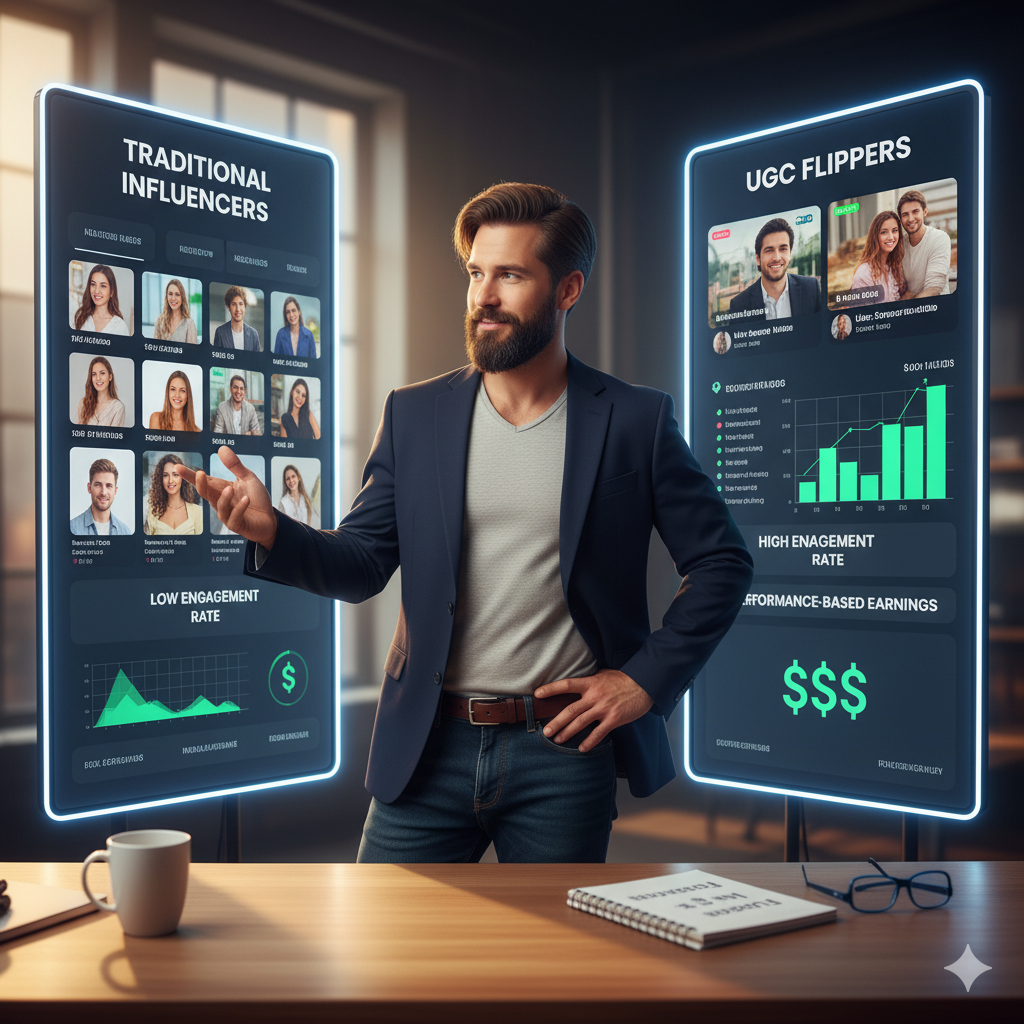Understanding the Dual Roles Shaping the Creator Economy
How Platforms, Monetisation Models and the Rise of flipitai Are Redefining the Landscape
The creator economy trends are shifting beneath our feet as new business models emerge and old ones evolve into fresh opportunities and challenges. Every day we witness creators, influencers, and flippers carving out niches, monetising content, and redefining value in a world where connectivity meets commerce. The phrase “creator economy trends” appears now in boardrooms, blog posts and investor decks alike, as the next wave of digital entrepreneurship takes shape. In this landscape we see two distinct archetypes: the influencer who builds audience trust and the flipper who monetises content assets or UGC strategies. These two roles overlap, clash and cooperate in an ecosystem full of innovation, risk and rapid change. This article unpacks how the creator economy trends are manifesting in 2025, why the flipper model is gaining traction, how influencers remain central — and how the SaaS platform flipitai (and its flipper-specific landing at flipitai/flipper) is positioned to capture this dynamic.
Table of Contents
The Rise of Influencers and Their Model
Influencers have long been the face of the creator economy trends, harnessing personal brand, authenticity and platforms to engage audiences and monetise attention. They build community, produce content regularly, and partner with brands for sponsorships, affiliate deals and co-creations. In 2025 the global creator economy is estimated at roughly USD 252.33 billion and expected to grow rapidly. (Grand View Research) Influencers dominate that value, yet the environment is far more competitive and fragmented than before. (EMARKETER) Their income models have diversified beyond simple ad revenue into memberships, merchandise, subscriptions, live events and direct-to-fan commerce. (Uscreen) The influencer’s strength is in trust — their audience sees them as a relatable peer rather than a billboard. As one academic paper noted, the value chains in influencer marketing emphasise relationships between firms, platforms, creators and followers. (ResearchGate) In this model the “influencer” remains central to shaping the trajectory of the creator ecosystem, yet emerging creator economy trends show that their role is evolving into something more entrepreneurial and asset-driven.
Enter the Flippers — A New Type of Creator Entrepreneur
Alongside influencers, a newer figure is rising in the creator economy trends: the flipper. Unlike the influencer whose primary asset is audience engagement and ongoing content creation, the flipper treats content, social accounts or UGC strategies as tradeable assets to be scaled, optimised and even sold. A flipper might use the SaaS tool flipitai (and the dedicated flipper portal at flipitai/flipper) to source, manage and monetise user-generated content campaigns across creators and platforms. Their business model centres on turning a content asset into multiple income streams: licensing, resale, affiliate funnels and strategic optimisation. This shift is one of the major creator economy trends in 2025 — content is no longer just a medium of expression but a tradable, scalable entity. In many ways, flippers mirror the entrepreneurial mindset studied in creator research: creators as business owners, not just content producers. (ScienceDirect) By leveraging tools, platforms and analytics, flippers are turning the creator economy from ad-based monetisation into asset-driven commerce.
Why Flippers Matter in 2025
Flippers matter because they represent a new axis in the creator economy trends — one that emphasises scale, efficiency and systemisation. As the market expands (with forecasts placing it near USD 528 billion by 2030) (inBeat) the ability to capture value via content assets becomes more important than ever. Brands and platforms are also recognising the value of UGC and content marketplaces, not just one-to-many creator deals. For example, tools that help creators scale content production, collaborate or syndicate across channels are becoming central in the ecosystem. The flipper approach aligns with this trend: small-to-medium creators can pool resources, use templates, leverage AI and create replicable systems. In turn, this creates new monetisation strategies such as flipping a video series to multiple creators, licensing content packs, or using affiliate networks at scale. The result is a more modular, scalable model of content commerce — exactly one of the major creator economy trends being flagged for 2025. (Disrupt)
How Influencers and Flippers Differ – And Where They Overlap
On the surface, influencers and flippers share many common elements: both operate in the creator economy trends, rely on digital platforms, and monetise creative work. Yet the differences matter. Influencers focus deeply on building and nurturing an audience, maintaining authenticity, community trust and continuous content output. They are often singular personalities, or small teams, whose monetisation depends on loyal followers and brand associations. On the other hand, flippers focus on optimizing content assets, scaling systems, trading content, and often working across multiple creators or niches. Their returns may come from repeated usage of content, licensing, resale, affiliate stacks and platform arbitrage rather than purely brand deals. Where they overlap: both use creator economy trends such as AI integration, diversification of revenue, longer-form content, platform expansion and direct-to-fan commerce. The smart creator, whether influencer or flipper, recognises the convergence: building audience + building assets. Platforms such as flipitai enable this convergence by offering both creator-centric and flipper-centric paths, linking audience insights with content asset optimisation.
Key creator economy trends Powering This Shift
In 2025 there are several key creator economy trends that are powering the growth of both influencers and flippers:
- AI Integration – Creators increasingly use AI tools for content generation, editing and scalability. (AdPushup)
- Platform Diversification – From mobile to TV screens, platforms are expanding and offering new monetisation routes. (Influencer Marketing Factory)
- Revenue Stream Diversification – Subscriptions, memberships, merch, licensing, and live-commerce are now common. (Uscreen)
- Content Asset Trading – Content is increasingly treated as a tradable asset and stackable product. (This aligns with the flipper model.)
- Creator-First Entrepreneurial Mindset – Creators see themselves as business owners, not just content producers. (ScienceDirect)
- Fragmentation and Consolidation – The ecosystem is fragmented but also showing early signs of consolidation via M&A, platform partnerships and talent networks. (EMARKETER)
These creator economy trends reflect a deeper shift: content and creator work are no longer ancillary to business, they are the business.
How flipitai Fits Into the Picture
The platform flipitai is built exactly for this new creator economy trends environment. For creators, it offers tools to manage user-generated content campaigns, scale production, analyse results, and monetise across creators and networks. For flippers, the dedicated landing at flipitai/flipper provides workflows to flip content assets, license campaigns, build affiliate stacks and manage creator networks. In doing so, flipitai bridges the influencer-asset divide: helping influencers treat their channel as an asset, while enabling flippers to engage creators as networked contributors. This dual-path model directly reflects the emerging creator economy trends of asset-orientation and monetisation diversification. By offering automation, analytics, collaboration and monetisation tools, flipitai positions itself at the heart of the next wave of creator-driven commerce.
Challenges and Considerations in the New Economy
While the momentum for creator economy trends is strong, there are real challenges and caveats. First, the monetisation barrier remains significant: even as the creator economy grows, many creators still earn under USD 15,000 annually. (Influencer Marketing Hub) Second, income inequality is stark — the “rich-get-richer” dynamic means top creators capture disproportionate value. (arXiv) Third, competition is intense: with over 200 million creators globally, standing out requires niche clarity, strategic monetisation and value creation. (inBeat) Fourth, platforms and algorithms continue to change rapidly — any creator (whether influencer or flipper) must adapt fast to algorithm shifts, platform policies and monetisation changes. Fifth, for flippers, treating content as a tradable asset introduces legal, rights-management and quality-control risks. Lastly, authenticity remains critical: even when content is scaled or flipped, the end audience still values trust, context and relevance — a reminder from influencer research about brand equity and value chains in the creator ecosystem. (ResearchGate)
Conclusion
The creator economy trends paint a picture of dynamic change, rich opportunity and nuanced strategic choices. Influencers continue to matter because they carry community, trust and ongoing engagement. Flippers matter because they turn content into scalable, tradable assets and unlock new monetisation frameworks. Together they illustrate the evolution of creator work from hobbyist side-hustle to full-fledged business models. Platforms such as flipitai (with its main landing and flipper-specific portal at flipitai/flipper) represent this shift by empowering both creators and flippers to capture value within the expanding creator economy. As the industry grows (with forecasts pointing to USD 500 billion and beyond) (Edelman) understanding these creator economy trends is critical for brands, creators and investors alike. The journey ahead is less about followers and more about assets, systems and smart monetisation. If you are a creator, a flipper or a brand wanting to partner in this space, recognise that the future of the creator economy lies in hybrid models, agile platforms and integrated value chains. The era of content as commerce is now — and the players who succeed will be those who think like influencers and flippers, adapting to the most important creator economy trends of our time.

We strongly recommend that you check out our guide on how to take advantage of AI in today’s passive income economy.




